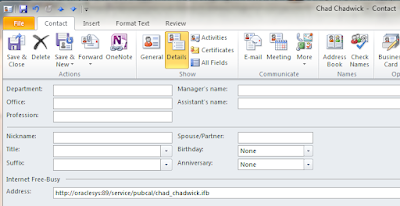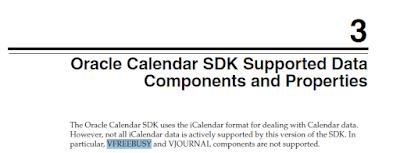Congratulations – you are dropping Oracle Calendar for Exchange. One problem: you need to stage it and you need some kind of connectivity between the two systems. This outlines how you can get Free/Busy lookups in Outlook / Exchange from OCS.
Outlook lets you have Internet Free Busy for Contacts:

SO: If we can produce IFBs for your OCS users (sorry about all the TLAs here), you can get Free-Busy lookups automatically working for your Outlook users into OCS.

Probably Oracle wanted to avoid exactly what we want in this case.
Not a problem. We can create VFREEBUSY from off the shelf tools in the OCS environment. In particular we will use the utility UNIICAL.
The solution works as follows:
· Select the OCS users you want to have Free-Busy available for in Outlook.
· Set up an internal share that is available to your OCS environment (you will be publishing to it) and your Exchange environment (you will be reading from it)
· One directory call “/…/EXPORT”
· Another directory call “/…/CURRENT”
· A third directory call “/…/IFB”
We’re going to take you through the process for one specific user, who we call Jimi.Hendrix
Create a batch file something like the following:
Uniical –export –u “S=Hendrix/G=Jimi” –f /…/EXPORT/jimi.hendrix.ics -n 1 –end 12/31/2011 –start 10/31/2011 –p PASSWORD |
Notes to this point: The above batch file hardcodes two dates. Obviously we want to make it general to start from TODAY and end at (TODAY + Default F/B Horizon). But let’s start with small ambitions and grow from there.
On a separate computer, we set up a process which interrogates the EXPORT ICS, compares it to the CURRENT ICS (say by comparing the MAX (CREATED) to see if it needs to parse or not), and if so moves it into the CURRENT and parses into an IFB. Practically any scripting language of your choice will work.
So what does ICS look like and what schematic takes it into IFB?
So what does ICS look like and what schematic takes it into IFB?
OCS ICS example
An OCS ICS file has a simple structure with a three-line preface before VEVENTS begin.
WARNING: Experimental evidence has shown that for this to work a contact with Internet Free Busy MUST be in your Contacts folder, not a subfolder, or a folder with any other name. |



No comments:
Post a Comment